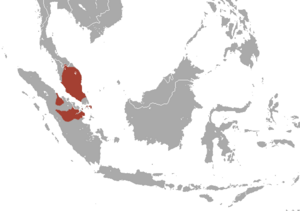White-thighed surili facts for kids
Quick facts for kids White-thighed surili |
|
|---|---|
 |
|
| On Pahang, Malaysia | |
| Conservation status | |
| Scientific classification | |
| Genus: |
Presbytis
|
| Species: |
siamensis
|
 |
|
| White-thighed surili range | |
The white-thighed surili (Presbytis siamensis) is a type of primate. It belongs to the family of old world monkeys. These monkeys live mostly in trees, in forests that are not too high up mountains. You can find them in the Thai-Malay Peninsula, the Riau Archipelago, and Sumatra.
This surili has four main types, called subspecies. They are named siamensis, cana, paenulata, and rhionis. They are easy to spot because of the white patches on the outside of their legs. This is how they got their name! Sometimes, people also call them pale-thighed langurs or surilis. These monkeys are very important for keeping the forests in Malaysia healthy and diverse.
Contents
About the White-Thighed Surili
What They Look Like
White-thighed surilis have a common surili body shape. They are about 41 to 69 centimeters (16-27 inches) tall. They weigh between 5 and 6.7 kilograms (11-15 pounds). Their bodies are slender. They have brown-grey fur on their backs. Their bellies are covered with white fur. Their heads have dark fur. The white fur on their outer thighs is their most famous feature. Their tails are usually dark and can be very long. They can reach about 58 to 85 centimeters (23-33 inches). Baby surilis are born with very light fur. They have dark fur crosses on their arms and backs.
Where They Live
White-thighed surilis are tree-dwelling animals. This means they spend most of their lives in trees. They live in warm, wet forest environments. You can find them in moist lowland areas or swamps. Sometimes, they even live in places like rural gardens. Their main home is the Malay Peninsula. They are also found in Sumatra and parts of Thailand.
How They Live Together
White-thighed surilis live in small groups. These groups usually have one male and several females. After a female gives birth, the other females in the group help care for the baby. Because they live in trees, they need to be good at spotting predators. Male surilis will make loud calls or create a distraction. This helps protect the group members from danger. This strategy works best when the groups are smaller.
Threats to Surilis
The IUCN Red List says that the white-thighed surili is "near threatened". This means they could become endangered if we don't protect them. Many surili species are affected by logging. Logging is when trees are cut down for wood. Even if some species are not on the official "red list," they are still in danger.
Protecting primates like the white-thighed surili is very important. People value these monkeys for many reasons. They are important for science and understanding genetics. They help keep forests healthy. They are also beautiful to look at and attract tourists. They are a symbol of nature's heritage. Researchers believe that teaching people about primate conservation is key. This will encourage more people to help protect them.
Right now, only about 30% of the forests on the Malaysian Peninsula are protected by law. This means 70% of the forests are still at risk from logging and other activities. We need more research on how many surilis there are. We also need to learn more about their daily lives and behaviors. This information will help create better plans to protect them.
Another danger to these monkeys is not related to logging. Sometimes, people try to keep them as pets. They are also sometimes used in the entertainment industry. To stop this, the white-thighed surili is listed under Appendix II of CITES. CITES is an international agreement that controls trade in wild animals and plants. Educating people about the illegal pet trade can help reduce the demand for these animals.


